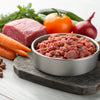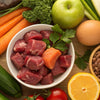When Can I Start Feeding My Dog Raw Food? A Comprehensive Guide for Pet Owners
- Houndsy
Table of Contents
- Introduction
- The Raw Food Diet Explained
- When Can I Start Feeding My Dog Raw Food?
- How to Transition Your Dog to Raw Food
- Which Raw Food Should I Choose?
- What to Expect When Switching to Raw
- Common Raw Feeding Myths Busted
- Conclusion
- FAQ Section
Introduction
Imagine this: you’re eagerly preparing dinner for your new puppy. What do you hope to provide? Nutrition? Excitement? A happy wagging tail? As modern pet parents, it’s natural to consider every angle of our canine companions’ nutrition. In fact, according to a recent survey by Mintel, 32% of dog owners prioritize health and wellness when choosing their pets’ food. Rising alongside this trend is the interest in raw feeding, a practice that many believe replicates the diet dogs would have evolved on in the wild.
As dog lovers, we often find ourselves asking, "When can I start feeding my dog raw food?" This blog post aims to answer that pivotal question while diving into the benefits and practicalities of introducing raw food to your pup. By the end, you’ll have a thorough understanding of how to transition your dog to a raw diet while ensuring their health and happiness.
We will explore critical elements such as the optimal age to start feeding raw, how to safely make the transition, what types of raw food to include, and much more. So, whether you’re a new pet parent or a seasoned pro looking to switch up your pup’s meal routine, get ready to embark on this exciting culinary journey together.
Let’s uncover everything you need to know about introducing raw food to your dog’s diet!
The Raw Food Diet Explained
Before we dive into the specifics of transitioning your dog to a raw diet, it's essential to understand what a raw food diet entails. At its core, the raw food diet consists of uncooked and unprocessed foods that aim to replicate what dogs would have eaten before being domesticated. This typically includes raw meat, bones, organs, and the occasional fruits and vegetables.
What Are the Benefits of Raw Feeding?
The raw food diet has garnered attention not only for its potential health benefits but also for supporting a more natural way of living for our furry friends. Here are some remarkable advantages that many pet owners experience:
-
Improved Digestion: Raw food is easier for dogs to digest, often leading to firmer stools and less gas. They thrive on the bioavailable nutrients found within raw meats and organs.
-
Healthier Coat: Many owners report shinier, healthier fur after switching to raw. This is mainly due to the healthy fats incorporated in the diet.
-
Enhanced Energy Levels: A raw diet often fuels dogs with the energy needed for their daily activities, resulting in a more playful demeanor.
-
Stronger Immune System: Nutrient-dense, unprocessed food can contribute to a robust immune system, making dogs less susceptible to illnesses.
-
Support for Dental Health: Chewing on raw bones promotes natural dental hygiene, which can lower the chances of gum disease.
Common Concerns About Raw Feeding
Despite these benefits, you might still wonder about the safety of feeding raw. Questions about bacteria and feeding practices may arise, leading to hesitation. It's crucial to note that while raw meat can harbor bacteria, maintaining proper hygiene and sourcing from reputable suppliers can minimize these risks significantly.
The American Veterinary Medical Association acknowledges that many dogs can thrive on a raw diet if done carefully. A consultation with a veterinarian familiar with raw feeding can help mitigate your concerns.
When Can I Start Feeding My Dog Raw Food?
Determining when to start your puppy on a raw food diet is a vital aspect of this transition.
Recommended Age to Introduce Raw Food
Puppies can typically start transitioning to raw food as early as three weeks old. This period marks when they begin to show interest in their mother’s food while still nursing. Gradually introducing raw food alongside their mother’s diet can help them adapt as they wean off. If your puppy was primarily weaned on processed foods, the transition may take a bit longer to ensure their digestive system adjusts accordingly.
Factors to Consider Before Starting
-
Consult Your Vet: Speak with a veterinarian experienced in raw feeding to create a tailored plan suited for your pup's age, size, and health.
-
Observe Your Pup: Every dog is unique, and careful monitoring helps ensure that they are adapting well to the raw diet.
-
Gradual Introduction: If your puppy is older and has only eaten processed food until now, a gradual transition over several days to weeks is essential for minimizing digestive issues.
How to Transition Your Dog to Raw Food
Transitioning your dog to a raw food diet doesn’t need to be overwhelming. Here's a step-by-step approach to making the change smooth for both you and your pup.
Step 1: Start Gradually
Begin by mixing a small amount of raw food with your puppy’s current diet. For instance:
- Days 1-3: 80% of their usual food, 20% raw.
- Days 4-6: 60% usual food, 40% raw.
- Days 7-9: 50% usual food, 50% raw.
- Days 10-12: 20% usual food, 80% raw.
- Day 13 onwards: 100% raw.
This gradual transition allows their digestive system to adjust adequately.
Step 2: Monitor Their Response
Keep an eye on your puppy’s digestion and stool consistency. It’s normal to see changes in their poop — smaller, less odorous poops are indicative of good digestion. Loose stools can occur but should not persist for more than a few days; if they do, revert to a previous food mixture to allow your dog time to adjust.
Step 3: Adjust Mixture As Needed
Every dog is different. If your pup seems to be struggling, slow down the transition or consult your vet for advice.
Which Raw Food Should I Choose?
Once you’ve decided to transition to raw feeding and identified the right timing, selecting what to feed your dog can feel daunting. Here are some recommended options:
Types of Raw Foods
-
Meats: Choose high-quality protein sources such as chicken, beef, turkey, lamb, and fish.
-
Bones: Raw, meaty bones can help with dental health and provide necessary nutrients. Never feed cooked bones, as they can splinter and cause severe injury.
-
Organ Meats: Liver, kidneys, and other organ meats are nutritional powerhouses. Aim to include organ meats in moderation.
-
Fruits and Vegetables: While dogs are primarily carnivorous, certain fruits and veggies can contribute to a well-rounded diet. Options like carrots, blueberries, and spinach can provide extra vitamins.
Products to Consider
While preparing raw meals from scratch is an option, many pet owners find convenience in commercially prepared raw food. For instance, our Houndsy Kibble Dispenser can also store to keep nutritious raw food fresh and accessible. Explore how we blend innovative design with functionality for the ultimate feeding experience here.
What to Expect When Switching to Raw
While many dogs adapt quickly to their new diet, some adjustments may be necessary. Here’s what you should keep in mind during this transition:
-
Digestive Changes: Dogs may experience initial digestive upset, such as loose stools or gas. This is often temporary and should resolve as they get accustomed to their new diet.
-
Hydration Needs: Raw food has higher moisture content. Your puppy might drink less water than they usually do.
-
Training Considerations: Raw-fed puppies tend to have better energy levels and are more engaged. Training becomes easier with heightened alertness and enthusiasm, benefiting the bonding experience.
Common Raw Feeding Myths Busted
Misconceptions about raw feeding often dissuade new pet parents from trying it. Let’s debunk some common myths:
-
Myth 1: Raw feeding is unsafe.
- Fact: With proper sourcing and handling, raw feeding can be safe. Many owners report improved health in their dogs once they switch to a raw diet.
-
Myth 2: Raw diets are balanced and complete on their own.
- Fact: It’s crucial to carefully formulate a raw diet to ensure it meets all nutritional needs, consulting with a vet or dietitian when necessary.
Conclusion
Feeding your dog a raw food diet can significantly contribute to their overall health, vitality, and happiness. From improving digestion to enhancing energy levels, the benefits of raw feeding are impactful. Timing is key; transitioning your puppy to raw food can start as early as three weeks, with careful monitoring throughout the process.
As you embark on this journey towards a healthier lifestyle for your furry friend, keep in mind the importance of gradual transitions, proper food choices, and consulting with your veterinarian. You might just find that introducing raw food brings a new level of excitement to mealtime—both for you and your puppy.
Ready to elevate your dog's feeding experience? Explore the innovative features of our Houndsy Kibble Dispenser and simplify your dog feeding regimen by clicking here.
FAQ Section
Q: Can I start feeding my puppy raw food at any age?
A: Puppies can be introduced to raw food as early as three weeks old. If they have transitioned from a processed diet, a gradual transition is recommended.
Q: Will my puppy experience digestive issues when switching to raw food?
A: Some dogs may experience temporary digestive upset, but these issues usually resolve as they adjust to their new diet.
Q: Is a raw food diet safe for all dogs?
A: Raw diets can be safe for most dogs. However, it's best to consult with a vet, especially if your dog has health issues or specific dietary needs.
Q: How much raw food should I feed my puppy?
A: The amount varies based on your puppy’s weight, age, and energy level. Generally, it's recommended to feed 2-3% of their body weight, but it's essential to consult your vet for specific guidelines.
Q: What are the signs that my puppy is reacting well to raw food?
A: Signs of a positive reaction to raw food include healthy energy levels, firm stools, shiny coat, and overall well-being. Monitor their behavior closely during the transition period.













